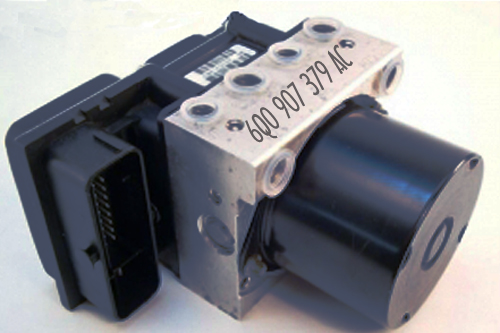VOLKSWAGEN ABS DIAGNOSTICS
Using a code reader or diagnostic tester to view your VW Polo ECU data is quite a treat and is also really cool. A view of the data just exudes the growth of motor vehicle technology in general and it is quite humbling if you are electronically minded and quite intimidating if you are mechanically minded. However there is often the temptation to change a number or something, just to see what happens to your Volkswagen. If you are one of those people who just did that, I bet you have a wistful regret, wishing that you never did so in the first place because you got yourself a "01044 control module incorrectly coded error." Or perhaps you swapped a 1996 VR6 engine into a 2007 MkV GTI chassis and got a "01044 control module incorrectly coded error." Or you had your car serviced and the ABS and ESP light stays on in the instrument panel and showing up as a "01044 control module incorrectly coded error." Or you cleared that nagging airbag light on your VW Beetle, only to get a "01044 control module incorrectly coded error."Control modules codings are normally NOT interchangeable since virtually every model among the numerous versions of VW's each have a different ABS/ESP module, Power Assisted Steerin Module, Climate control Module, Instrument Module, Immobilizer Module and Engine Control Module and so many other modules. Taking this into consideration, it is more than obvious that one should NEVER copy coding from a different model VW, AUDI, SKODA or SEAT and paste it into your own Volkswagen, AUDI, SKODA or SEAT, unless you write down your original modules original coding so that you can revert back to it later, should things appear to go pear shaped.
However if the two VW, AUDI, SKODA, or SEAT are the same in every respect, then their module codings will be identical and therefore perfectly fine to use. Be particular about the module suffix since different suffixes signify different software versions which may not be compatible to your VAG car. Virtually each module that appears identical but has different letter suffixes will invariable have a different coding. So the rule is same car, same module, same module number, same module suffice, same coding. Disregarding this could incapacitate your car and cost you a huge amount of money.
Every Control module coding is stored as an onboard binary number, which in essence is the binary sum of the features for that specific module. Whereas the ECU also stores an onboard binary number which is the binary sum of all the Control Modules fitted in the car. This binary sum is called the checksum and any incorrectly coded module will result in an erroneous checksum. If this is the case, the erroneous checksum is compared to a reference checksum also stored in the ECU module and any discrepancy could incapacitate your Volkswagen completely or present you with some peculiarities and error codes to match. Like the notorius 01044 control module incorrectly coded. Checksum verification was adopted by BOSCH Motronic ECUs to validate its EPROM's stored data. Having said that, it is wise not to change the coding or replace any control modules in your VW AUDI, SKODA or SEAT unless you are au fait with binary and hexadecimal number systems.
Below, is a list of VW ABS controllers and their respective coding which vary from 'ABS FRONT MK60 0101' to 'ABS 8.0 front H03 0002' to 'ABS 8.0 front H05 0002' to 'ABS 5.7 FRONT V20' to 'ABS 5.7 FRONT V30 ' to 'ABS/ASR 5.7 FRONT V20' to 'ABS 5.7 FRONT V00' to 'ESP 8.0 front H03 0001' to 'MABS 8.0 front H04 0002' to 'ESP 8.0 front H03 0001' to 'ABS 8.0 front H03 0002' to mention but a few. Several VW, AUDI, SKODA and SEAT owners and mechanics are constantly searching the Internet for ABS module coding and hopefully this information may help them to get their Volkswagens, Skodas, Seats, Audis and other VAG cars up and running once again.
 |
| VW POLO 6Q0 907 379 AC ABS Pump |
VW Polo 9N
Address 03: ABS Brakes
Controller: 6Q0 907 379 AC
Component: ABS 8.0 front H03 0002
Coding: 0000145
ALTERNATIVE ABS MODULE CODING
NB! These are the codings I currently have but are certainly not the only ones use by Volkswagen, SEAT, Skoda and Audi. As I get them I will update this list.
6Q0 907 379 - Coding: 00036 or 00044
6Q0 907 379 AA - Coding: 0000005 or 0000008
6Q0 907 379 AB - Coding: 0000005 or 0000008
6Q0 907 379 AC - Coding: 0000145 or 0000142
6Q0 907 379 AF - Coding: 0002061 or 0002079 or 0002082 or 0002085 or 0002103 or 0002115 or 0002118 or 0002122 or 0002136 or 0002145 or 0002175 or 0002181 or 0002190 or 0002193 or 0002199 or 0002202
As can be seen above, AF suffix has the whole gamut of codings and each should be tried before throwing in the towel.
6Q0 907 379 AG - Coding: 0002202 or 0002229 or 0002238
6Q0 907 379 AH - Coding: 0000299 or 0000284
6Q0 907 379 AQ - Coding: 0002356
6Q0 907 379 AS - Coding: 0002347 or 0002368 or 0002368 or 0002491
6Q0 907 379 AT - Coding: 0000269
6Q0 907 379 BC - Coding: 0002136 or 0002098
6Q0 907 379 C - Coding: 00044
6Q0 907 379 D - Coding: 00124 or 00188
6Q0 907 379 E - Coding: 0001097
6Q0 907 379 G - Coding: 00044 or 00045
6Q0 907 379 H - Coding: 00188
6Q0 907 379 L - Coding: 0001097
6Q0 907 379 M - Coding: 0000000
6Q0 907 379 R - Coding: 0000008
6Q0 907 379 T - Coding: 0000281 or 0000296 or 0000299
 |
| Make some quick money |
 |
| Eat as much as you like at Alfonso's Wedding |
 |
| A Classic Wedding Cake |













